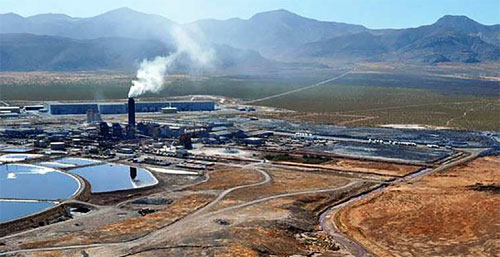Brice Wallace
Utah state government is targeting a magnesium producer as it looks to improve air quality along the Wasatch Front.
Gov. Spencer Cox has asked the U.S. Environmental Protection Agency to include US Magnesium’s Rowley operations in Tooele County into what is known as the Northern Wasatch Front ozone nonattainment area. Such an area does not meet federal air quality standards. {mprestriction ids="1,3"}
Meanwhile, the Utah Legislature passed HB220, a bill calling for the Utah Division of Air Quality to conduct an inventory, formulate a plan and provide recommendations related to certain emissions, specifically sources that emit halogens, as a way of limiting those emissions.
Halogens have been reported to influence the formation of secondary air pollutants.
“Utah has made significant strides in improving air quality over the past 10 years, but as our state continues to grow, we need to begin to look more strategically at opportunities to continue this trajectory,” Cox said. “This intentional approach gives us a focused range of tools that align with the outcome we all want: cleaner air and a better quality of life for Utahns.”
US Magnesium’s website says the Rowley plant along the southwestern edge of the Great Salt Lake is the largest producer of primary magnesium in North America. The plant has been operating since 1972.
The proprietary process used by the company was originally developed by the National Lead Co. in 1972. Ownerships changes include Amax in 1980, MagCorp in 1989 and US Magnesium LLC in 2002.
“The company,” according to the website, “has repeatedly made significant capital investments to increase magnesium production capacity, while concurrently reducing the environmental footprint.”
The site says over $120 million has been invested to develop and implement energy-efficient electrolytic cells and gas-capturing equipment, increasing magnesium production capacity by more than 30 percent while reducing chlorine emissions by 99 percent, air emissions by 95 percent, and unit energy consumption by 25 percent.
The plant uses water from the lake, which is evaporated to produce a brine solution that is then purified and dried before going through a melt reactor and electrolytic process that separates magnesium metal from chlorine. Byproducts include volatile organic compounds (VOCs) and oxides of nitrogen (NOx), as well as chlorine that is converted into hydrochloric acid.
“All of these byproducts contribute to ozone and secondary particulate matter formation” in the nonattainment area, the state says.
The facility’s emissions make the plant one of the largest point sources of VOCs and NOx in the greater Wasatch Front, and the facility also is also a unique source of halogen emissions that have been shown to impact both summer and wintertime pollution, Cox said.
Utah has reduced VOCs as part of its fine particulate matter state implementation plan (SIP), but the state needs additional tools to address summertime ozone pollution along the Wasatch Front, Cox said.
The Utah division has identified the US Magnesium plant as a major industrial source that contributes to the degradation of the area’s airshed while being outside of the existing boundary of the nonattainment area. The plant “has significant amounts of highly reactive precursor emissions that contribute to both ozone and [particulate] formation along the Wasatch Front,” Cox said.
“The adjustment of the boundary to include US Magnesium will allow DAQ to implement emission reduction strategies that will directly address the area’s air quality challenges,” he said.
The governor’s letter was sent to Kathleen Becker, EPA Region 8 administrator, who has 18 months to approve or deny Utah’s request.
HB220, sponsored by Rep. Andrew Stoddard, D-Sandy, calls for the air emissions inventory of halogen emitters by the end of 2024, with implementation of the reduction plan by the end of 2026, as well as recommendations for a state standard for limiting halogen emissions.
The Utah Division of Air Quality has worked to identify VOC reduction strategies that will both improve air quality and meet the state’s obligations under the Clean Air Act, which include the state identifying and implementing a 15 percent reduction in VOCs.{/mprestriction}








